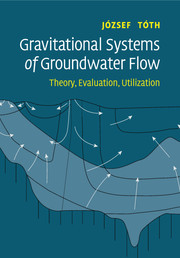Book contents
- Frontmatter
- Contents
- Preface
- 1 Introduction
- 2 The ‘Unit Basin’
- 3 Flow patterns in composite and heterogeneous basins
- 4 Gravity flow of groundwater: a geologic agent
- 5 Practical applications: case studies and histories
- 6 Epilogue: gravitational systems of groundwater flow and the science of hydrogeology
- Glossary
- References
- Appendices
- Appendix A
- Appendix B
- Index
3 - Flow patterns in composite and heterogeneous basins
Published online by Cambridge University Press: 31 July 2009
- Frontmatter
- Contents
- Preface
- 1 Introduction
- 2 The ‘Unit Basin’
- 3 Flow patterns in composite and heterogeneous basins
- 4 Gravity flow of groundwater: a geologic agent
- 5 Practical applications: case studies and histories
- 6 Epilogue: gravitational systems of groundwater flow and the science of hydrogeology
- Glossary
- References
- Appendices
- Appendix A
- Appendix B
- Index
Summary
Effects of basin geometry
Owing to the functional relations between boundary conditions and hydraulic head distribution in a flow domain (Eqs. 2.1 and 2.2, respectively), changes in the geometry of the unit basin modify the patterns of flow and fluid-dynamic parameters. Typically, the result is an increase in the complexity of the basic distributions. Regional flow patterns are sensitive to two principal aspects of a basin's geometry, namely, the configuration of the water table and the relative depth of the basin, i.e. its depth-to-width ratio (Tóth, 1963).
The analysis below follows Tóth's (1963) original study. First, the linear upper boundary of the unit basin is replaced by an undulating sinusoidal surface superimposed on a linear regional slope. Next, the basin's depth is changed while keeping the width of the basin's flank constant. The effects of significant breaks in the regional slope are then illustrated by conceptual schemata of four major types of regional land forms: (a) V-notch canyons, (b) intracratonic broad upland basins, (c) intermontane broad valleys, (d) cordillera-cum-foreland basins. Finally, Zijl's (1999) analysis of the effect of scale of the water-table's relief on flow-system types and their depth of penetration, and of the relation between spatial and temporal scales is reviewed.
- Type
- Chapter
- Information
- Gravitational Systems of Groundwater FlowTheory, Evaluation, Utilization, pp. 33 - 90Publisher: Cambridge University PressPrint publication year: 2009



